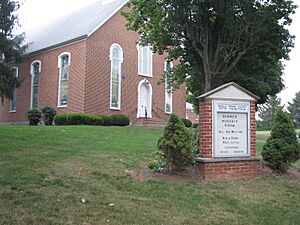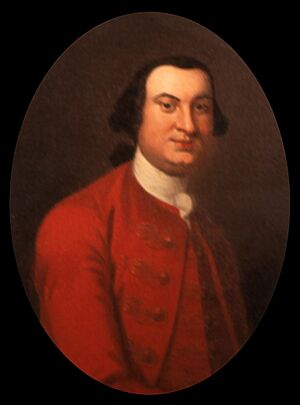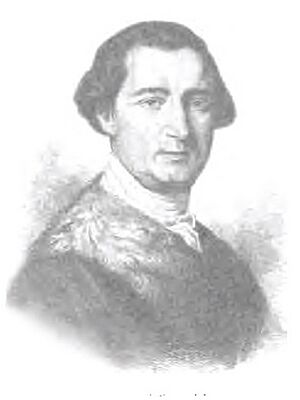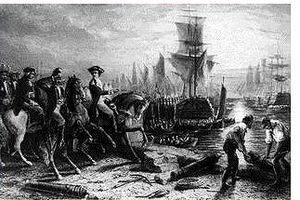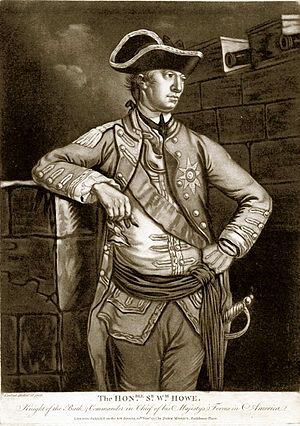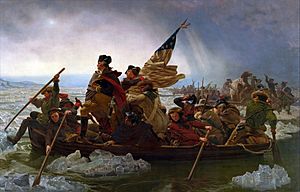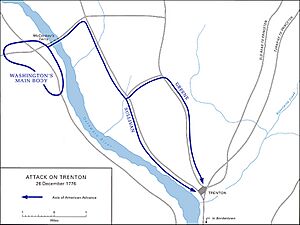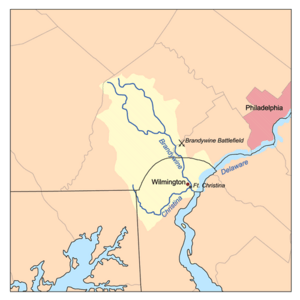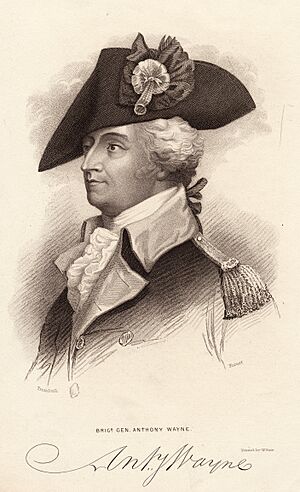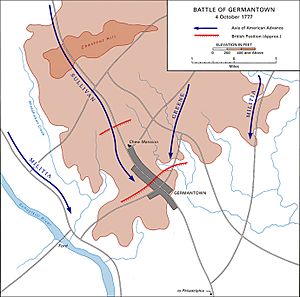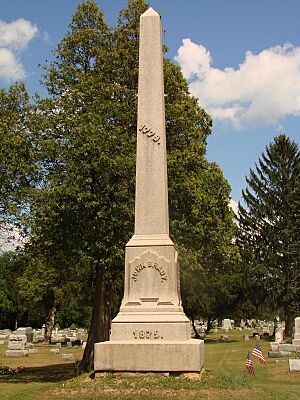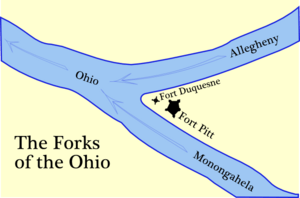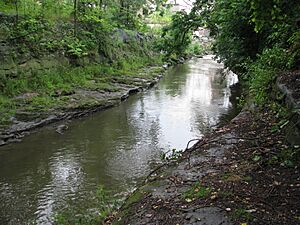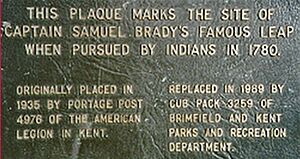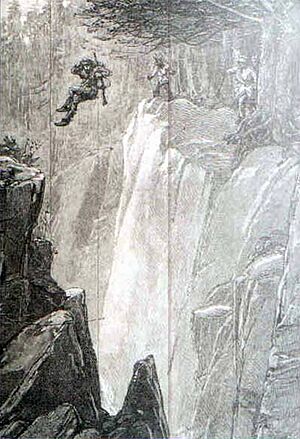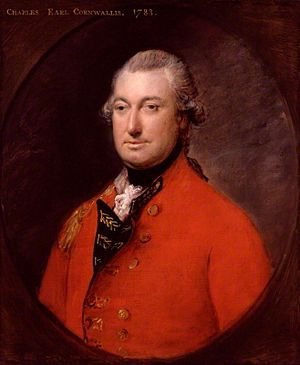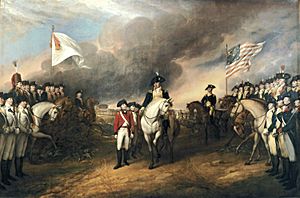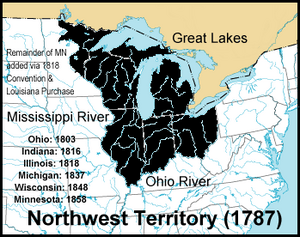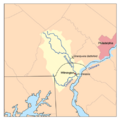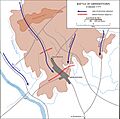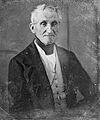Samuel Brady facts for kids
Quick facts for kids
Samuel Brady
|
|
|---|---|
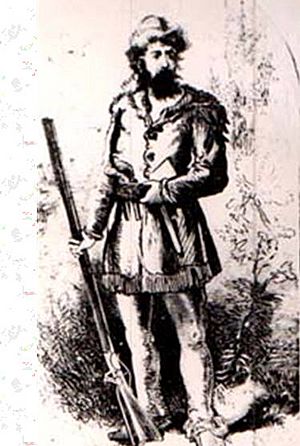
Early illustration of Captain Samuel Brady, circa 18th-19th centuries
|
|
| Born | May 5, 1756 Shippensburg, Cumberland County, Province of Pennsylvania (British Royal Colony), British North America, British Empire, present-day Shippensburg, Cumberland County, Maryland
|
| Died | December 25, 1795 (aged 39) |
| Nationality | American |
| Occupation | soldier, colonial militia officer, scout, Indian fighter |
| Employer | Continental Congress and the U.S. Government |
| Known for | Being a French and Indian War and Revolutionary War soldier, frontier scout, and a notorious Indian fighter, on the early American frontier |
| Title | Captain |
| Relatives | Hugh Brady |
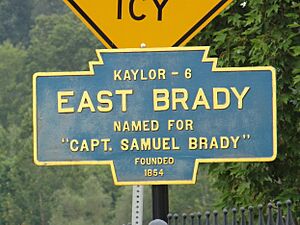
Captain Samuel Brady (1756–1795) was an Irish American officer during the American Revolutionary War. He was a brave frontier scout and a famous "Indian fighter" in the history of western Pennsylvania and northeastern Ohio. Many legends are told about him. He is most famous for reportedly jumping across a gorge over the Cuyahoga River. This happened when he was escaping from Native Americans in what is now Kent, Ohio. This amazing jump is still called "Brady's Leap".
Contents
Samuel Brady's Family Background
Samuel Brady was born on May 5, 1756, in Shippensburg, Pennsylvania. His father was Captain John Brady. He was a soldier who died in 1779 during a Native American attack. Samuel's mother was Mary Quigley Brady. She was born in 1735 and passed away in 1783. Samuel had many brothers and sisters. There were thirteen children in total, but three died when they were babies.
Who were the Quigleys?
Samuel's grandfather, James Quigley, came to America from Ireland around 1730. He settled on about 400 acres (1.6 km²) of land in Pennsylvania. This area is now Hopewell Township, Cumberland County. He built a log home near Conodoguinet Creek. This spot later became known as "Quigley's Bridge."
James Quigley and his wife, Jeanette, were very careful to protect their family from Native American attacks. Many of their neighbors faced danger. In 1756, James Quigley became an ensign in the Cumberland County Colonial Rangers. He also served as a private in the Revolutionary War. He died in 1782.
Who were the Bradys?
The Brady family was also very important in the early history of the area. Samuel's grandparents were Hugh Brady and Hannah McCormick. They may have come from Ireland. They first lived in Delaware, where Samuel's father, John, was born in 1733.
Later, Hugh and Hannah Brady moved to Cumberland County, Pennsylvania. They settled near the Quigley family. They were neighbors and attended the same church. Hugh and Hannah had nine children. At least six of their seven sons served in the Revolutionary War. Hugh and Hannah Brady are buried in the old cemetery of the Middle Spring Presbyterian Church.
Samuel's Father, Captain John Brady
Samuel's father, John Brady, was a surveyor. He became an Ensign in the colonial troops in 1760. This was during the war against the French and Native Americans.
French and Indian War
John Brady fought in the French and Indian War. This war was between the British and the French. Both sides had Native American allies. The British were on the Atlantic Coast of North America. The French were mostly in Canada. Both countries wanted control of land in what is now Michigan, western Pennsylvania, and Ohio.
The war started in 1756. Native American tribes often allied with the French. They attacked British settlers on the Pennsylvania frontier. This was the area where the Brady and Quigley families lived. John Brady joined the fight against these attacks. The war ended in 1763 with the Treaty of Paris. France lost most of its land in North America.
Pontiac's War
After the French and Indian War, Native American threats continued. In 1763, Pontiac's War began. Chief Pontiac united tribes that had been French allies. They continued to fight the British. John Brady became a Captain in 1763. He fought in the Pennsylvania Regiments during Pontiac's War.
Captain John Brady fought against Native American forces. These forces were attacking many frontier families in Pennsylvania. Pontiac's forces captured many forts and settlements. They also surrounded Fort Pitt (now Pittsburgh) and Fort Ligionier. British Colonel Henry Bouquet led troops to break these sieges. Captain John Brady was part of this expedition.
Fort Brady
Samuel's father, Captain John Brady, received land for his service. He built a private fort on this land in 1776. He called it "Fort Brady." It was near what is now Muncy, Pennsylvania. The fort was made of tall logs set in a deep trench.
Fort Brady was very close to the edge of the frontier. The other side of the Susquehanna River was controlled by Native Americans. They often crossed the river to raid settler homes. Settlers also crossed to chase raiding parties. This led to a cycle of violence. Captain John Brady chose to settle his family in this dangerous area. This greatly influenced his son, Samuel Brady.
Samuel Brady's Service in the American Revolution
The Brady family fought in many important battles during the first two years of the American Revolution.
Battle of Boston
The American Revolution began with the Battle of Boston. Captain John Brady took his sons Samuel and James to fight with General George Washington in Boston. Samuel and James Brady joined the Continental Army as privates on August 3, 1775. Samuel was nineteen years old.
Samuel Brady showed great courage and calmness in battle. Once, a cannonball hit a fence where he and his captain were sitting. Samuel was the first to get up. He helped his captain, saying, "We are not hurt, captain." Washington's army forced the British to leave Boston on March 17, 1776.
Battle of New York
The British tried to invade New York City. They landed on Long Island, New York, in August 1776. This was the first major battle after the Declaration of Independence. The British army, led by Major General Lord William Howe, defeated Washington's forces.
Samuel Brady was promoted to lieutenant soon after this battle. He was recognized for his bravery at the Battle of Long Island. He was tall and strong, with great endurance. His brother James became a sergeant.
The British then captured New York City. Washington had to retreat to Harlem Heights. Samuel Brady also fought in the Battle of White Plains on October 28, 1776. Washington had to retreat again. The British captured Fort Washington and Fort Lee.
Battle of Trenton
After taking New York City, British General William Howe moved towards Philadelphia. Samuel Brady was part of a key American victory. He crossed the Delaware River with General Washington. This happened on the night of December 25-26, 1776. They attacked Howe's forces at the Battle of Trenton.
Trenton, New Jersey was held by German soldiers hired by the British, called "Hessians." Washington's army was tired and morale was low. Many soldiers were leaving. Washington needed a victory. His army marched through snow to Trenton. They attacked the Hessians in the morning and won a complete victory. Samuel Brady was a crucial part of this battle. It helped keep the American Revolution alive.
Battle of Princeton
Samuel Brady also fought at the Battle of Princeton on January 3, 1777. Before this, there was a Second Battle of Trenton on January 2, 1777. Washington positioned his troops to defend against a British counter-attack. British General Charles Cornwallis attacked, but the Americans held their ground.
That night, Washington secretly moved his army. He left campfires burning to trick the British. He marched his army around Cornwallis. Then, he attacked the British forces in Princeton, New Jersey. Samuel Brady was in the middle of this fight. Washington personally led a charge to save the day for his army. Cornwallis was surprised to hear fighting behind him. By the time he arrived, Washington's army had slipped away again.
Battle of Brandywine Creek
In 1777, General Howe tried to capture Philadelphia. General Washington made his last major stand at the Brandywine River. This battle was about thirty miles southwest of Philadelphia. Lieutenant Samuel Brady fought under General Anthony Wayne at Chadds Ford.
On September 11, 1777, General Howe outflanked Washington and won the battle. However, Howe was slow to follow up. This allowed most of the American army to escape. Samuel's fifteen-year-old brother, John, was wounded in this battle. Samuel's father, Captain John Brady, was also wounded. He lost several teeth and later became ill. He was sent home from the army.
Paoli Massacre
Samuel Brady is remembered for his actions at the "Paoli Massacre" in Chester County, Pennsylvania. After the Battle of Brandywine Creek, Washington's army retreated. General Wayne's division was sent to harass the British army from behind. They camped near the "General Paoli Tavern."
British loyalists in the area told the British where Wayne's troops were. On September 20, 1777, General Howe attacked Wayne's Pennsylvanians at night. The British used no flints in their muskets to stay quiet. The American soldiers were surprised and had to flee. Many were killed.
Lieutenant Samuel Brady was one of those who escaped. He helped others get away. He was called "The Jumper" because he leaped across a wide gap to escape. He tore his coat free from bayonets, shot a British soldier, and ran to a swamp. He and 55 other men rejoined the army the next morning.
Battle of Germantown
Philadelphia fell to the British on September 26, 1777. The Continental Congress wanted Washington to take it back. Washington decided to attack the British forces in Germantown, Pennsylvania. This was the last major battle Samuel Brady fought as a regular soldier.
Washington planned a surprise night attack on October 4, 1777. However, his army moved slowly and had poor coordination. They arrived at dawn and met British units quickly. The British fought bravely and pushed back the Americans. The Colonials suffered heavy losses.
Valley Forge
After the defeat at Germantown, Washington's army camped at Valley Forge. The winter of 1777-1778 was very harsh. Soldiers faced extreme cold and lack of supplies. Samuel Brady likely spent this difficult winter with George Washington at Valley Forge.
Samuel Brady's Frontier Service in the Revolution
In 1778, General Washington sent the Pennsylvanian soldiers to the Pennsylvania and Ohio frontiers. This was their home territory, and they knew it well. Samuel Brady served as a scout with these forces. He was known for his skill and bravery. George Washington himself praised Samuel's service. Samuel Brady was promoted to Captain in the Continental Army on August 2, 1779.
Brother James Dies in Native American Attack
Samuel's strong desire to fight Native Americans grew from the deaths of his brother, James Brady, and his father, Captain John Brady.
On June 10, 1778, Native Americans attacked a family near Williamsport, Pennsylvania. James Brady was part of a group of soldiers sent to protect settlers. The Native Americans attacked in the morning fog. Most of the soldiers fled, but James stayed to fight. He was shot in the arm but managed to kill two attackers. He was then hit in the head with a tomahawk and stabbed with a spear.
Miraculously, James survived. He was taken to his mother's home in Sunbury, Pennsylvania. His mother, Mary Quigley Brady, was heartbroken. James died five days later, on August 13, 1778. Samuel Brady rushed home but arrived after his brother's death. He swore he would get revenge for James.
Father John Dies in Ambush
Samuel's father, Captain John Brady, returned to duty in September 1778. His wife, Mary, faced many hardships at home. She gave birth to her thirteenth child, Liberty, just before James died. She named her daughter Liberty to celebrate American independence.
Captain John Brady was killed in a Native American ambush on April 11, 1779. His body was brought to his home at Fort Brady. He was buried on a hillside nearby. A monument was later built there to honor him.
Samuel was serving under Colonel Daniel Brodhead at Fort Pitt (now Pittsburgh) when he heard about his father's death. In his grief, he vowed to avenge his father's murder. He promised to never be at peace with Native Americans of any tribe. He kept this promise.
His Mother Mary's Hardship
After her husband died, Mary Quigley Brady moved with her children to her parents' home. She stayed there for several months. In October, she felt she had to return to Fort Brady. She led a cow and carried her baby, Liberty, on horseback.
The winter of 1779-1780 was very harsh. Many neighbors were killed by Native Americans in the spring. Women in the area often stayed at Fort Muncy for safety. But Mary insisted on sharing the danger with her sons. She cooked for them and worked alongside them. Her son Hugh often walked with his brother John, carrying a rifle while John plowed.
A Vengeful Frontier Fighter
Captain Samuel Brady spent the rest of the Revolution defending settlers. He became famous as a "Indian fighter" and a spy. He operated out of Fort Pitt and later Fort McIntosh. Fort McIntosh was on the very edge of the frontier.
In June 1779, after his father's death, Native Americans attacked a family near Fort Pitt. They killed a mother and her four children. They took a boy and his sister captive. Captain Brady rushed out with a guide to rescue them. The Native Americans were from the Seneca and Munsee tribes.
Captain Brady and his guide found their camp near Brady's Bend, Pennsylvania. In the morning, Captain Brady attacked. He killed an old chief and eight warriors. The children were rescued. This event likely led to stories about Samuel Brady's encounters with a chief named Bald Eagle. Some stories claim Bald Eagle killed Samuel's brother, James. They also say Samuel Brady killed Bald Eagle in revenge. However, historians dispute this. There is a historical marker at Brady's Bend, Pennsylvania, that mentions this disputed event.
Brady's Leap
Samuel Brady is most famous for his leap over the Cuyahoga River around 1780. This happened in what is now Kent, Ohio. He was chasing a group of Sandusky Native Americans. His ambush failed, and they chased him. To escape, Brady leaped across a 22-foot (6.7 m) wide gorge of the river.
He then fled to a nearby lake. He hid in the water under a fallen tree, breathing through a hollow reed. This lake is now called Brady Lake. The place where he jumped is now "Brady's Leap Park."
Captain Samuel Brady and his Rangers were pursuing a group of Sandusky Native Americans in Ohio. They ambushed them near what is now Brady's Lake. Most of the Native Americans were killed. However, a larger group arrived. Brady's Rangers were overwhelmed. Some escaped, but most were killed. The Native Americans captured Captain Brady.
They planned to burn him at the stake. But he managed to escape by loosening his ropes. He was unarmed and hundreds of Native Americans were chasing him. He ran for a long time, eating berries and roots.
Finally, he reached the Cuyahoga River. The river was deep and dangerous, with rocks rising 25 feet high. The narrowest part was 23 to 30 feet wide. The Native Americans thought they had him trapped. But Brady ran back into the forest to get a good start. He heard their shouts as he jumped across the wide gap. He landed safely on the other side. One of his pursuers reportedly said, "Brady made good jump. Indian no try."
Brady was wounded in the leg after his jump. The Native Americans crossed the river at a ford and continued to chase him. Exhausted, he slipped into Brady Lake. He hid underwater, breathing through a hollow reed. The Native Americans waited, thinking he had drowned. They eventually gave up. Captain Brady emerged and made it back to Fort McIntosh, alive but injured.
Spying on Native Americans
Captain Samuel Brady was very good at gathering information about Native Americans. In 1780, he went on a spying mission into Ohio. He disguised himself as a Native American. He drew a map of the area and marked the locations of Native American towns.
He got very close to a main town. He managed to capture two horses and two Native American women. As he neared the Ohio River, one woman escaped. While chasing her, he found a captive settler woman, Jenny Stupes, and her two children.
He saw a warrior on horseback with Jenny and her children. Brady shot the warrior dead without harming Jenny. He was still in disguise. Jenny thought he was a Native American. She asked, "Why did you kill your brother?" Brady replied, "Why, Jenny, don't you know me? I am Sam Brady." He then took Jenny, her children, and his other prisoner to safety at Fort Pitt. Years later, Jenny Stupes helped rescue Captain Samuel Brady.
In 1782, General George Washington ordered Fort Pitt's commander, General Brodhead, to send his best scouts into Native American territory. Brodhead chose Captain Brady. Brady picked Lewis Wetzel as his companion. Brady and Wetzel disguised themselves as Shawnees. They went to a large Native American council in Sandusky, Ohio. They pretended to want to join the attack on white settlers.
Their trick worked for a while. They learned important details about the attack plans. But an old chief became suspicious. Brady immediately shot him dead. Wetzel shot another chief. They escaped on two horses. When one horse tired, they took turns riding and running. They reached the Ohio River and swam across. It was very cold, and their clothes froze. To save Wetzel, Brady killed their horse, removed its insides, and put Wetzel inside to keep him warm while he built a fire. This daring escape exposed the Native American plans. Both scouts were praised for their courage.
After the Revolution
The American Revolution ended when Samuel Brady was 27. The war effectively ended when British General Lord Charles Cornwallis surrendered at Yorktown, Virginia, on October 17, 1781. The official end was with the Treaty of Paris, signed on September 3, 1783.
Death of Samuel's Mother Mary
Captain Samuel Brady's mother, Mary Quigley Brady, died on October 20, 1783. She was 48 years old. She had been ill for a long time due to the hardships of frontier life. She lived to see American Independence. Some of her children were still young when she died. Her older children, especially her daughter Mary, cared for the younger ones.
Mary Brady married Captain William Gray in 1784. They took all of Mary's younger brothers and sisters, except Hugh, to live with them. Samuel's brother Hugh Brady went to live with Captain Samuel Brady in Washington County, Pennsylvania. Hugh later became an ensign in General Anthony Wayne's army in 1792.
Marriage to Drusilla Swearingen
Samuel Brady met his wife, Drusilla Swearingen, around 1783. She was the daughter of his commanding officer, Captain Van Swearingen. They met at Holliday's Cove Fort in what is now Weirton, West Virginia.
Drusilla was born around 1769. Her father wanted her to marry someone more refined than Samuel. But Samuel and Drusilla fell in love. One evening, Samuel rode to her home with an extra horse. Drusilla jumped on, and they eloped. Her father eventually forgave them. He even built them a home on his land. Samuel and Drusilla lived in Chartiers Creek, Pennsylvania.
They later moved to what is now Ohio County, West Virginia. They settled near Wellsburg. In 1793, they moved to Short Creek. Samuel and Drusilla had three children: William, Van Swearingen, and John.
Battle for the Northwest Territory
Native Americans saw the British as allies during the Revolution. They wanted to stop settlers from moving into their lands around the Great Lakes. This area was called the "Northwest Territory." The British gave this land to the United States in the Treaty of Paris without asking their Native American allies.
The Native Americans, united as the Western Indian Confederacy, fought back. They were led by Blue Jacket of the Shawnees and Little Turtle of the Miami tribe. The British also encouraged this resistance. In 1790 and 1791, the Native Americans won big victories against the United States.
President George Washington then formed a new army called the "Legion of the United States." He asked General Anthony Wayne, Samuel Brady's former commander, to lead it. Wayne recruited and trained this army. When Samuel was cleared of accusations of killing Native Americans, General Wayne made him a captain again. He put Samuel in charge of all the army's spies. Samuel's brother Hugh also joined Wayne's army.
General Wayne moved his army into Ohio. On August 20, 1794, Wayne attacked the Native American forces in what is now Maumee, Ohio. Wayne won a decisive victory at the Battle of Fallen Timbers. This forced the Native Americans to make peace. In 1795, the Treaty of Greenville was signed. This treaty gave most of Ohio to the United States, opening it for settlement.
Samuel's brother, Hugh Brady, continued to fight in various Native American wars and the War of 1812. He eventually became a major general in the United States Army.
Death
Captain Samuel Brady died of pleurisy on December 25, 1795. He was in Short Creek, West Virginia. He was only 39 years old. He was remembered as a brave fighter and a protector of settlers. His wife, Drusilla Brady, died on January 9, 1823.
Images for kids
-
A Keystone Marker for East Brady, Pennsylvania, named for Samuel Brady.




